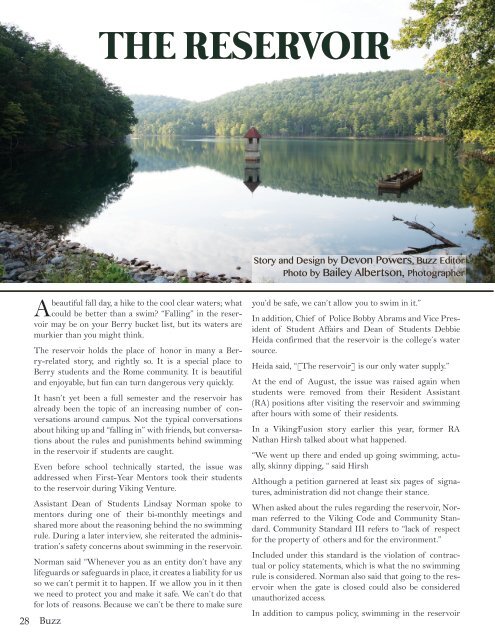Valkyrie Fall 2017 - Issue 1
Valkyrie is a lifestyle and culture magazine designed for college students. Produced by Berry College students.
Valkyrie is a lifestyle and culture magazine designed for college students. Produced by Berry College students.
You also want an ePaper? Increase the reach of your titles
YUMPU automatically turns print PDFs into web optimized ePapers that Google loves.
THE RESERVOIR<br />
beautiful fall day, a hike to the cool clear waters; what<br />
A could be better than a swim? “<strong>Fall</strong>ing” in the reservoir<br />
may be on your Berry bucket list, but its waters are<br />
murkier than you might think.<br />
The reservoir holds the place of honor in many a Berry-related<br />
story, and rightly so. It is a special place to<br />
Berry students and the Rome community. It is beautiful<br />
and enjoyable, but fun can turn dangerous very quickly.<br />
It hasn’t yet been a full semester and the reservoir has<br />
already been the topic of an increasing number of conversations<br />
around campus. Not the typical conversations<br />
about hiking up and “falling in” with friends, but conversations<br />
about the rules and punishments behind swimming<br />
in the reservoir if students are caught.<br />
Even before school technically started, the issue was<br />
addressed when First-Year Mentors took their students<br />
to the reservoir during Viking Venture.<br />
Assistant Dean of Students Lindsay Norman spoke to<br />
mentors during one of their bi-monthly meetings and<br />
shared more about the reasoning behind the no swimming<br />
rule. During a later interview, she reiterated the administration’s<br />
safety concerns about swimming in the reservoir.<br />
Story and Design by Devon Powers, Buzz Editor<br />
Photo by Bailey Albertson, Photographer<br />
you’d be safe, we can’t allow you to swim in it.”<br />
In addition, Chief of Police Bobby Abrams and Vice President<br />
of Student Affairs and Dean of Students Debbie<br />
Heida confirmed that the reservoir is the college’s water<br />
source.<br />
Heida said, “[The reservoir] is our only water supply.”<br />
At the end of August, the issue was raised again when<br />
students were removed from their Resident Assistant<br />
(RA) positions after visiting the reservoir and swimming<br />
after hours with some of their residents.<br />
In a VikingFusion story earlier this year, former RA<br />
Nathan Hirsh talked about what happened.<br />
“We went up there and ended up going swimming, actually,<br />
skinny dipping, “ said Hirsh<br />
Although a petition garnered at least six pages of signatures,<br />
administration did not change their stance.<br />
When asked about the rules regarding the reservoir, Norman<br />
referred to the Viking Code and Community Standard.<br />
Community Standard III refers to “lack of respect<br />
for the property of others and for the environment.”<br />
is prohibited by state and federal regulations because it is<br />
the water supply for the college. Heida said that the college<br />
asked the state whether they would authorize swimming<br />
in the reservoir several years ago and the answer<br />
was no. According to the Georgia Department of Health<br />
and Rule 391-3-16-.01 Criteria for Water Supply Watersheds<br />
Section 8 regarding Water Supply Reservoirs Management<br />
Plans, swimming is prohibited in the reservoir.<br />
Even though Berry College is a private college, it is still<br />
required to follow federal regulations.<br />
In a survey emailed to the student body, <strong>Valkyrie</strong> asked<br />
students what they thought the punishment for swimming<br />
in the reservoir was. The answers varied from there is no<br />
punishment to loss of job or probation. So, what does happen<br />
to you if you get caught swimming in the reservoir?<br />
Although there has been an increase in conversation about<br />
reservoir, Norman believes that the number of incidents<br />
and subsequent consequences is consistent.<br />
“How we find out about it ebbs and flows in terms of<br />
amount and that may make students feel like it is inconsistent<br />
in terms of enforcement. It’s not inconsistent; if<br />
we know about it, we hold students accountable. We don’t<br />
know about it all the time, we don’t police our students<br />
that way. Lately other students will bring it to my attention<br />
when they see it. I don’t actively go look.”<br />
According to Chief Abrams, campus police have never<br />
criminally charged students for swimming in the reservoir.<br />
Dean Heida said the punishment depends on the<br />
situation.<br />
“The challenge is [students] know we haven’t treated<br />
every situation the same and again, all of the details about<br />
every situation are not the same. Rarely are situations alike<br />
so if it’s just an individual or a couple students then its<br />
dealt with somewhat differently than if you’re in a leadership<br />
position or involve others in what you’re doing or if<br />
it’s after dark and the gate is closed already. Our primary<br />
goal with any conduct situation is education,” Heida said.<br />
As a part of the student conduct system, Norman gave<br />
some insight into the process. The administration will<br />
receive documentation, in the form of a police report, an<br />
incident report or a screenshot of something from a student.<br />
Norman herself will then arrange a follow-up conversation<br />
with the student in question.<br />
“That’s an administrative hearing and its very informal.<br />
[The students] come and we just talk about the risks and<br />
I try to understand why the student did it and help them<br />
see why we have concerns and ask them not to do it in the<br />
future,” Norman said.<br />
that every time someone is caught, they at least have an<br />
administrative hearing. Heida also confirmed that administrative<br />
hearings always occur when a student is in trouble.<br />
Page 51 of the Viking Code lays out the procedure for<br />
administrative hearings.<br />
“Administrative hearings are generally reserved for minor<br />
infractions, or when the student and investigator agree<br />
on administrative adjudication. Procedures include the<br />
respondent’s right to:<br />
1. written notification of charges<br />
2. an opportunity for the accused student, hereafter<br />
referred to as respondent, and the hearing officer to<br />
review documentation and discuss the alleged behavior.<br />
3. a fair and impartial consideration of the charges by<br />
the hearing officer<br />
4. the right to present a defense including information<br />
about potential witnesses to be interviewed by the<br />
investigative or hearing officer<br />
5. the right to a written notification of finding<br />
6. the right to appeal the decision<br />
Administrative hearings are informal in nature and involve<br />
the hearing officer and the respondent. Information from<br />
witnesses is received either in written form or interviews<br />
by the investigating officer. Administrative hearings are<br />
not taped.”<br />
The two main rationales behind the no swimming rule<br />
are the safety concerns of a student getting hurt and the<br />
subsequent difficulty of emergency vehicles getting to the<br />
scene and the fact that it is our drinking water and against<br />
regulations to swim in it.<br />
Student Government Association President Kassie Jones<br />
understands the complexity of the safety concerns of the<br />
reservoir and believes that students will take the rules<br />
about the reservoir seriously if they are enforced with<br />
more consistency.<br />
“Students like to think they are three things: invulnerable,<br />
invincible and infertile and they are none of the three. My<br />
strongest hope is that something bad doesn’t have to happen<br />
for students to take it seriously. That would hurt my<br />
heart and be devastating to the community,” said Heida.<br />
Included under this standard is the violation of contractual<br />
or policy statements, which is what the no swimming<br />
Norman said “Whenever you as an entity don’t have any<br />
lifeguards or safeguards in place, it creates a liability for us<br />
rule is considered. Norman also said that going to the reservoir<br />
when the gate is closed could also be considered<br />
the case to the Conduct Board, made up of faculty and<br />
Norman or the student then have the opportunity to refer<br />
so we can’t permit it to happen. If we allow you in it then<br />
we need to protect you and make it safe. We can’t do that<br />
unauthorized access.<br />
staff and students, if they so choose. While a case may not<br />
for lots of reasons. Because we can’t be there to make sure<br />
always be heard before the Conduct Board, Norman said<br />
In addition to campus policy, swimming in the reservoir<br />
28 Buzz<br />
VALKYRIE 29














